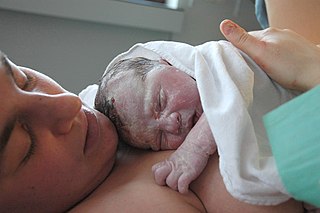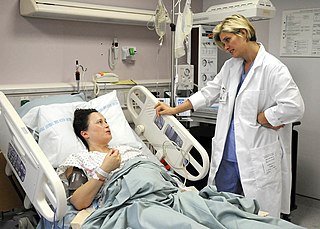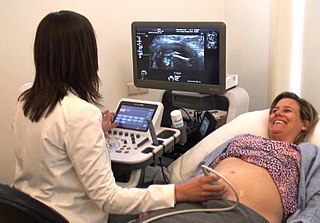Related Research Articles

Midwifery is the health science and health profession that deals with pregnancy, childbirth, and the postpartum period, in addition to the sexual and reproductive health of women throughout their lives. In many countries, midwifery is a medical profession. A professional in midwifery is known as a midwife.

Childbirth, also known as labour and delivery, is the ending of pregnancy where one or more babies exits the internal environment of the mother via vaginal delivery or caesarean section. In 2019, there were about 140.11 million births globally. In the developed countries, most deliveries occur in hospitals, while in the developing countries most are home births.
A birthing center is a healthcare facility, staffed by nurse midwives, midwives and/or obstetricians, for mothers in labor, who may be assisted by doulas and coaches. The midwives monitor the labor, and well-being of the mother and the baby during birth. Doulas can assist the midwives and make the birth easier. Should additional medical assistance be required, the mother can be transferred to a hospital. This transfer is more likely if an epidural is needed, there is meconium staining, it is a prolonged labor, or the newborn needs intensive care. Some hospitals have birth centers as an alternative to the usual high tech maternity wards.

A home birth is a birth that takes place in a residence rather than in a hospital or a birthing center. They may be attended by a midwife, or lay attendant with experience in managing home births. Home birth was, until the advent of modern medicine, the de facto method of delivery. The term was coined in the middle of the 19th century as births began to take place in hospitals.

External cephalic version (ECV) is a process by which a breech baby can sometimes be turned from buttocks or foot first to head first. It is a manual procedure that is recommended by national guidelines for breech presentation of a pregnancy with a single baby, in order to enable vaginal delivery. It is usually performed late in pregnancy, that is, after 36 gestational weeks, preferably 37 weeks, and can even be performed in early labour.

William Smellie was a Scottish obstetrician and medical instructor who practiced and taught primarily in London. One of the first prominent male midwives in Britain, he designed an improved version of the obstetrical forceps, established safer delivery practices, and through his teaching and writing helped make obstetrics more scientifically based. He is often called the "father of British midwifery".

In the United States, a Certified Nurse-Midwife (CNM) is a nurse midwife who exceeds the International Confederation of Midwives essential competencies for a midwife and is also an advanced practice registered nurse, having completed registered nursing and midwifery education leading to practice as a nurse midwife and credentialing as a Certified Nurse-Midwife. CNMs provide care of women across their lifespan, including pregnancy and the postpartum period, and well woman care and birth control. Certified Nurse-Midwives are exceptionally recognized by the International Confederation of Midwives as a type of midwife in the U.S.

A traditional birth attendant (TBA), also known as a traditional midwife, community midwife or lay midwife, is a pregnancy and childbirth care provider. Traditional birth attendants provide the majority of primary maternity care in many developing countries, and may function within specific communities in developed countries.

NETS is an acronym for newborn emergency transport service orsystem. Such services provide critical care transport for newborn babies requiring care not available in the hospital of birth. Some provide other services; such as outreach education, return transport and coordination of high-risk obstetric transfer. Others provide transport services in older age-groups.

Maternal–fetal medicine (MFM), also known as perinatology, is a branch of medicine that focuses on managing health concerns of the mother and fetus prior to, during, and shortly after pregnancy.

Obstetrical forceps are a medical instrument used in childbirth. Their use can serve as an alternative to the ventouse method.
The estimated date of delivery (EDD), also known as expected date of confinement, and estimated due date or simply due date, is a term describing the estimated delivery date for a pregnant woman. Normal pregnancies last between 38 and 42 weeks. Children are delivered on their expected due date about 4% of the time.
The following outline is provided as an overview of and topical guide to obstetrics:
This article covers psychiatric complications of childbirth, as apposed to those of pregnancy or the postpartum period. Despite modern obstetrics and pain control, childbirth can leave a lasting impact for many women. During delivery, or immediately afterwards, the following complications are occasionally seen: delirium, stupor, rage, acts of desperation, or neonaticide. With great improvements in obstetric care as a result of modern medicine, psychiatric complications are rarely seen in patients under proper medical supervision. There is, however, a great contrast between Europe, North America, Australia, Japan and other countries with advanced medical care, and the rest of the world. The wealthiest nations represent 10 million births each year out of the world's total of 135 million. These nations have a maternal mortality rate (MMR) of 6–20/100,000. Poorer nations with high birth rates can have an MMR more than 100 times as high. In Africa, India & South East Asia, and Latin America, these complications of parturition may still be as prevalent as they have been throughout human history.

Addis Ababa Fistula Hospital, also known as AAFH and Hamlin Fistula Hospital, is a health care hospital based in Addis Ababa, Ethiopia. Its regional Hamlin Fistula centres provide care for women who suffer from incontinence, physical impairment, shame and marginalisation as a result of an obstetric fistula. The hospital was created by the Australian obstetrician and gynaecologists Catherine Hamlin, and her husband Reginald Hamlin, to care for women with childbirth injuries and has been in operation since 1974. It is in Addis Ababa, the capital of Ethiopia. It is the only hospital of its kind in the world dedicated exclusively to women with obstetric fistula, and it treats all patients free of charge. Patients undergo surgical repair by Ethiopian and expatriate surgeons trained at the hospital's main facility in Addis Ababa. Around 93% of these patients are successfully treated.
Princess Margaret Hospital (PMH) on Funafuti atoll in Tuvalu is the only hospital in the country, and the primary provider of medical services for all the islands of Tuvalu. The hospital is located about 1.3 kilometres north from the centre of Funafuti on Fongafale islet.

Joseph Bolivar DeLee was an American physician who became known as the father of modern obstetrics. DeLee founded the Chicago Lying-in Hospital, where he introduced the first portable infant incubator. Early in his career, he was associated with the medical school at Northwestern University. After 1929, he was employed by the medical school at the University of Chicago.

A midwife is a health professional who cares for mothers and newborns around childbirth, a specialization known as midwifery.

A nurse midwife is both a nurse and a midwife, having completed nursing and midwifery education leading to practice as a nurse midwife and sometimes credentialed in the specialty. Nurse midwives provide care of women across the lifespan, including during pregnancy and the postpartum period, and well woman care and birth control.

No Pain Labor & Delivery – Global Health Initiative is a non-for-profit organization. Founded in 2006, the program focuses on correcting the unnecessarily high caesarean delivery rate and the poor utilization of neuraxial labor analgesia in China.
References
- Liang DYS. The emergency obstetric service, Belshill Maternity Hospital: 1933–61. J Obstet Gynecol Br Commonwealth 1963; 70:83-93.
- Chamberlain G, Pearce JM. The flying squad. Br J Obstet Gynaecol 1991; 98:1067-9.
- Callander C, Hutton P. The anaesthetist and the obstetric flying squad. Could complacency creep in? Anaesthesia 1986; 41:721-5.